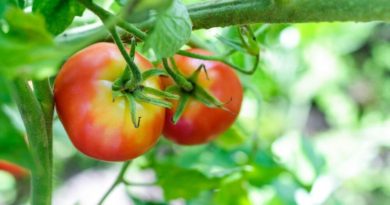Edimental Gardening with Red-Stalked Rhubarb
You know it for its massive ornamental leaves and tart-tasting stalks; rhubarb is the perfect edimental plant that serves the ecosystem in many ways!
We’re all about edimental gardens here at Garden Culture Magazine because the plants in your growing space should look fantastic and taste great! Who doesn’t want a garden to work overtime and serve many different purposes? Rhubarb is an incredible selection for the edimental garden; it’s impressive-looking, is excellent groundcover, and makes for a delicious spring harvest.
What is Rhubarb?
Contrary to popular belief, rhubarb (Rheum rhabarbarum) is not a fruit; it’s a vegetable! Renowned for its large dark green ornamental leaves, the plant produces tart red edible stalks in late spring.
Rhubarb’s Services to the Ecosystem
Don’t use chemical fertilizers on a young rhubarb plant because nitrates kill it. Apply organic compost and manure to nourish the plant and enrich the soil around it. If you allow a rhubarb plant to bolt (produce a flower), the blossom’s nectar will attract and feed pollinators. The irony is that rhubarb is self-pollinating and doesn’t need fertilizing help! It also grows quite large and, like hostas, makes for good, edible groundcover.
Soil, Light and Planting
Rhubarb prefers slightly acidic soil that is high in organic matter. It also likes moist roots. A good rule is to water when the top layer of soil feels dry to the touch. Rhubarb is sun-loving and needs at least six hours of direct sunlight daily. Hardy to climate zone 3 (-40°C), some varieties of rhubarb, once established, will grow for 20 years or longer, so when choosing a spot to plant – be wise. Make sure no nearby tree or shrub will eventually grow and shade out the plant.
Gardeners often purchase crowns or root divisions rather than start rhubarb from seed. Rhubarb can be grown in a container, but I can tell you from experience that it won’t be happy. Container soil dries quickly, so the plant needs constant watering and winter protection in a greenhouse or unheated garage or basement. Picky about temperatures, in summer, rhubarb prefers 20-25°C. Outside this range, it will grow best as an annual, not an edimental; this makes it the perfect plant for northern climates.
Propagating Rhubarb
Propagating rhubarb is done by division in the spring, just as the new shoots poke above the ground. Carefully dig around the plant and lift it completely free of the soil. Rhubarb has an extensive root system, so start at least a half meter away from the plant and dig inwards. Once the clump is out of the ground, use a sharp knife or shovel to divide it into several pieces. Replant each new division. It’s that easy.
Rhubarb Pests and Problems
Rhubarb’s garden enemies are slugs and weeds. It is a heavy nitrogen feeder, and if it competes with other plants for this nutrient, it won’t be as productive. A good layer of mulch will suppress hungry weeds. A circle of stones around the base of the plant will also help deter slugs who aren’t fans of crawling over the hard surface for a snack.
Rhubarb and the Fruits of Your Labors
You can harvest rhubarb the second year after planting. Stop picking the stalks by early summer to let the plant grow and store energy for the following spring.
Sadly, not all parts of this edimental are yummy. Rhubarb leaves and roots are toxic to people and pets. But the stalks make great pies, tarts, jams, jellies, and crisps. One of my favorites is a tart apple and rhubarb crisp topped with ice cream.
Put the leaves to good use with this organic DIY pesticide! Rhubarb leaves help deter spider mites and aphids.
Happy Edimental Gardening!




